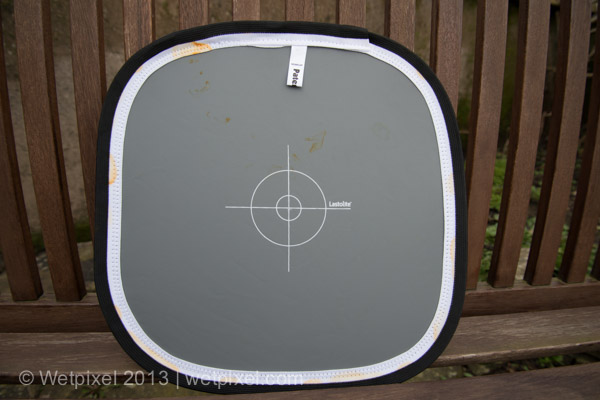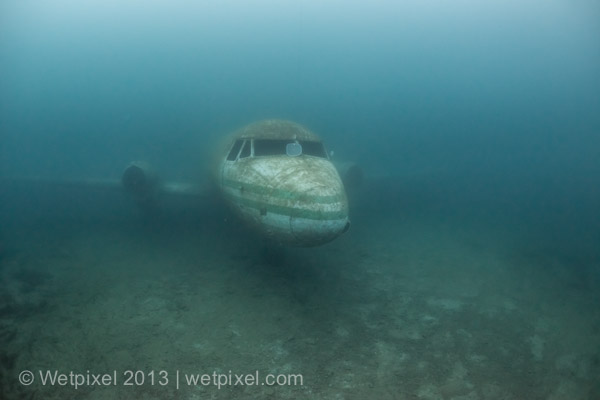Review: Lastolite EzyBalance color balance target

At the DEMA show of 2012, Ryan Canon, owner of Reef Photo and Video, asked me if I would review the Lastolite EzyBalance waterproof color balance target. Lastolite produces a wide range of white balance targets, including the LL LR1252 model designed specifically for underwater use. This is described as a tool for adjusting color balance and exposure settings in both still and video cameras. The collapsible square is made of a waterproof wipe-clean surface material sewn to a sprung steel rim, which allows it to be folded down to roughly a third of its 12” expanded size. It has a white side and an 18% grey balance target side.


Color (or white) balance is an adjustment that allows the user to set a neutral or mid tone, thereby keeping other colors within the image or video in proportion. If a color balance is not performed correctly, this can result in a color cast, or the colors within the image or video being shifted in one or other direction.
How and when color balance is achieved will vary depending on how light is applied during capture. If an external light source, such as a strobe or video light is used, the best way to ensure consistent color is by trying to match the camera’s white balance setting to that of the light source’s output. Alex Mustard has written an excellent article on this. Even so, in some specific situations it may be productive to incorporate a color balance target into the shooting process. The example that springs to mind here would be underwater studio or commercial work.
However, for ambient light capture, some form of color correction or balance is mandated to compensate to some extent for the absorption of light in the water column. The use of some color correction filters, like Green water or Original Magic filter require the user to color balance their cameras every couple of meters of depth difference. This is where the use of a color balance target is a useful addition to the shooter’s tools.


The first use is similar to how, in studio environments, light and white balance are set by metering using a light meter and color balance check placed close to the subject. Underwater, this means that the camera will attempt to compensate for the color shift during capture. This involves performing a manual white balance in the camera using the EzyBalance as a reference. Most cameras will need some light to be falling onto the target in order to set the white balance, that is, it will not work if the target is in the shade. Used correctly, this should produce images that have no color cast straight out of the camera. The major limitation of this technique is that it will only work at relatively shallow depths, as the drop off in light’s color range is fairly rapid as it is absorbed in the water column.

The second use is to use the target in post processing to ensure that whatever software is used, an exact 18% grey can be used as a reference. If the EzyBalance is placed into the subject, and an image then taken, this image then serves as a reference to use with post capture software to correct color. It is easy to place the target onto the subject, take an image of it and then use this image to correct any color casts in the subsequent images. Lightroom’s white balance selector tool, combined with the ability to sync setting over multiple images makes for a fast and efficient workflow and is an easy and effective way of achieving this. The only drawback is that this technique only works with subjects that are largely static.

The control of color cast is a fundamental tool in creating images with color that look “right” to the viewer. Color balance targets represent one way of achieving this. I experimented with it both being held by another diver as a color balance target in order to manually white balance my camera, and also as a reference for color balancing in post.

The EzyBalance is small and portable enough to be appropriate for use underwater. It folded down into a size that can sit in a BCD or drysuit pocket, and not be a hinderance. It is supplied with a case, but I found that this was not much use underwater, and felt that the zips that were used to close it would not survive long in a marine environment. Whilst on the subject, you can see in some of the above images that the test unit has suffered from some rust marks. I assume that this is due to the steel frame rusting when the EzyBalance was stored in my fin pocket for a period between shoots. If this is the case, the user needs to pay special attention to ensuring that the EzyBalance is dried thoroughly after each use.

My last suggestion would be that it needs some sort of grommet or attachment point for a lanyard. It is so much easier to simply clip it to a D ring in-between shots, rather than having to fold it up and stow it away. This is something that could be easily fashioned by the user, but it would be nice if it was incorporated into the design.
The EzyBalance LL LR1252 is available from Reef Photo and other outlets at a price of $39.95.
FTTC Disclosure:
The EzyBalance that was used for the test was supplied to me free of charge by Ryan Canon of Reef Photo and Video for the purposes of this review. He has not asked for it back yet! Many thanks to him for providing it.